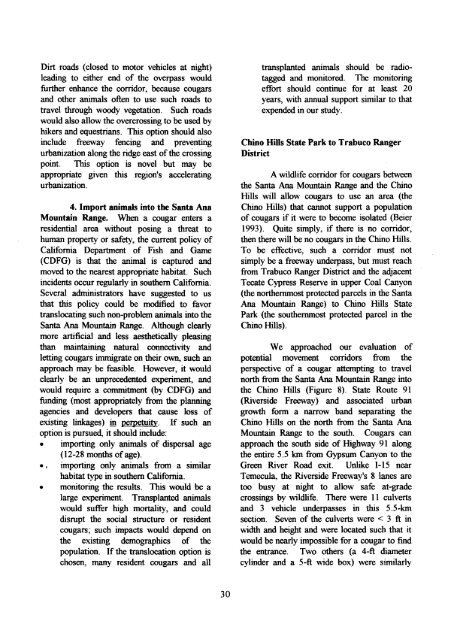the cougar in the santa ana mountain range, california
the cougar in the santa ana mountain range, california
the cougar in the santa ana mountain range, california
Create successful ePaper yourself
Turn your PDF publications into a flip-book with our unique Google optimized e-Paper software.
Dirt roads (closed to motor vehicles at night)<br />
lead<strong>in</strong>g to ei<strong>the</strong>r end of <strong>the</strong> overpass would<br />
fur<strong>the</strong>r enhance <strong>the</strong> corridor, because <strong>cougar</strong>s<br />
and o<strong>the</strong>r animals often to use such roads to<br />
travel through woody vegetation. Such roads<br />
would also allow <strong>the</strong> overcross<strong>in</strong>g to be used by<br />
hikers and equestrians. This option should also<br />
<strong>in</strong>clude freeway fenc<strong>in</strong>g and prevent<strong>in</strong>g<br />
urbanization along <strong>the</strong> ridge east of<strong>the</strong> cross<strong>in</strong>g<br />
po<strong>in</strong>t. This option is novel but may be<br />
appropriate given this region's accelerat<strong>in</strong>g<br />
urbanization.<br />
4. Import animals <strong>in</strong>to <strong>the</strong> Santa Ana<br />
Mounta<strong>in</strong> Range. When a <strong>cougar</strong> enters a<br />
residential area without pos<strong>in</strong>g a threat to<br />
human property or safety, <strong>the</strong> current policy of<br />
California Department of Fish and Game<br />
(CDFG) is that <strong>the</strong> animal is captured and<br />
moved to <strong>the</strong> nearest appropriate habitat. Such<br />
<strong>in</strong>cidents occur regularly <strong>in</strong> sou<strong>the</strong>rn California.<br />
Several adm<strong>in</strong>istrators have suggested to us<br />
that this policy could be modified to favor<br />
translocat<strong>in</strong>g such non-problem animals <strong>in</strong>to <strong>the</strong><br />
Santa Ana Mounta<strong>in</strong> Range. Although clearly<br />
more artificial and less aes<strong>the</strong>tically pleas<strong>in</strong>g<br />
than ma<strong>in</strong>ta<strong>in</strong><strong>in</strong>g natural connectivity and<br />
lett<strong>in</strong>g <strong>cougar</strong>s immigrate on <strong>the</strong>ir own, such an<br />
approach may be feasible. However, it would<br />
clearly be an unprecedented experiment, and<br />
would require a commitment (by CDFG) and<br />
fund<strong>in</strong>g (most appropriately from <strong>the</strong> plann<strong>in</strong>g<br />
agencies and developers that cause loss of<br />
exist<strong>in</strong>g l<strong>in</strong>kages) <strong>in</strong> perpetuity. If such an<br />
option is pursued, it should <strong>in</strong>clude:<br />
• import<strong>in</strong>g only animals of dispersal age<br />
(12-28 months ofage).<br />
• , import<strong>in</strong>g only animals from a similar<br />
habitat type <strong>in</strong> sou<strong>the</strong>rn California.<br />
• monitor<strong>in</strong>g <strong>the</strong> results. This would be a<br />
large experiment. Transplanted animals<br />
would suffer high mortality, and could<br />
disrupt <strong>the</strong> social structure or resident<br />
<strong>cougar</strong>s; such impacts would depend on<br />
<strong>the</strong> exist<strong>in</strong>g demographics of <strong>the</strong><br />
population. If <strong>the</strong> translocation option is<br />
chosen, many resident <strong>cougar</strong>s and all<br />
30<br />
transplanted animals should be radiotagged<br />
and monitored. The monitor<strong>in</strong>g<br />
effort should cont<strong>in</strong>ue for at least 20<br />
years, with annual support similar to that<br />
expended <strong>in</strong> our study.<br />
Ch<strong>in</strong>o Hills State Park to Trabuco Ranger<br />
District<br />
A wildlife corridor for <strong>cougar</strong>s between<br />
<strong>the</strong> Santa Ana Mounta<strong>in</strong> Range and <strong>the</strong> Ch<strong>in</strong>o<br />
Hills will allow <strong>cougar</strong>s to use an area (<strong>the</strong><br />
Ch<strong>in</strong>o Hills) that cannot support a population<br />
of <strong>cougar</strong>s if it were to become isolated (Beier<br />
1993). Quite simply, if <strong>the</strong>re is no corridor,<br />
<strong>the</strong>n <strong>the</strong>re will be no <strong>cougar</strong>s <strong>in</strong> <strong>the</strong> Ch<strong>in</strong>o Hills.<br />
To be effective, such a corridor must' not<br />
simply be a freeway underpass, but must reach<br />
from Trabuco Ranger District and <strong>the</strong> adjacent<br />
Tecate Cypress Reserve <strong>in</strong> upper Coal Canyon<br />
(<strong>the</strong> nor<strong>the</strong>rnmost protected parcels <strong>in</strong> <strong>the</strong> Santa<br />
Ana Mounta<strong>in</strong> Range) to Ch<strong>in</strong>o Hills State<br />
Park (<strong>the</strong> sou<strong>the</strong>rnmost protected parcel <strong>in</strong> <strong>the</strong><br />
Ch<strong>in</strong>o Hills).<br />
We approached our evaluation of<br />
potential movement corridors from <strong>the</strong><br />
perspective of a <strong>cougar</strong> attempt<strong>in</strong>g to travel<br />
north from <strong>the</strong> Santa Ana Mounta<strong>in</strong> Range <strong>in</strong>to<br />
<strong>the</strong> Ch<strong>in</strong>o Hills (Figure 8). State Route 91<br />
(Riverside Freeway) and associated urban<br />
growth form a narrow band separat<strong>in</strong>g <strong>the</strong><br />
Ch<strong>in</strong>o Hills on <strong>the</strong> north from <strong>the</strong> Santa Ana<br />
Mounta<strong>in</strong> Range to <strong>the</strong> south. Cougars can<br />
approach <strong>the</strong> south side of Highway 91 along<br />
<strong>the</strong> entire 5.5 km from Gypsum Canyon to <strong>the</strong><br />
Green River Road exit. Unlike 1-15 near<br />
Temecula, <strong>the</strong> Riverside Freeway's 8 lanes are<br />
too busy at night to allow safe at-grade<br />
cross<strong>in</strong>gs by wildlife. There were 11 culverts<br />
and 3 vehicle underpasses <strong>in</strong> this 5.5-km<br />
section. Seven of <strong>the</strong> culverts were < 3 ft <strong>in</strong><br />
width and height and were located such that it<br />
would be nearly impossible for a <strong>cougar</strong> to f<strong>in</strong>d<br />
<strong>the</strong> entrance. Two o<strong>the</strong>rs (a 4-ft diameter<br />
cyl<strong>in</strong>der and a 5-ft wide box) were similarly
















